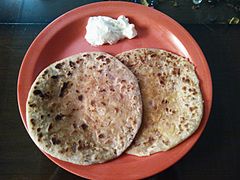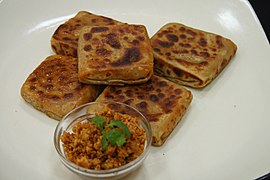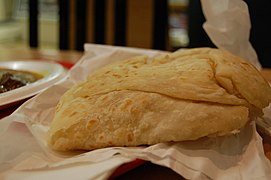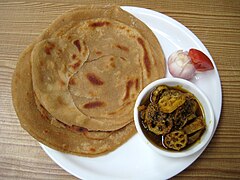Paratha (pronounced [pəˈɾɑːtʰɑː], also parantha/parontah) is a flatbread native to the Indian subcontinent,[1][4] with earliest reference mentioned in early medieval Sanskrit, India;[1] prevalent throughout the modern-day nations of India, Pakistan, Nepal, Bangladesh, Maldives, Afghanistan, Myanmar,[3] Malaysia, Singapore, Thailand, Mauritius, Fiji, Guyana, Suriname, and Trinidad and Tobago where wheat is the traditional staple. It is one of the most popular flatbreads in the Indian subcontinent and the Middle East.[5][6] Paratha is an amalgamation of the words parat and atta, which literally means layers of cooked dough.[7] Alternative spellings and names include parantha, parauntha, prontha, parontay, paronthi (Punjabi), porota (in Bengali), paratha (in Odia, Urdu, Hindi), palata (pronounced [pəlàtà]; in Myanmar),[3] porotha (in Assamese), forota (in Chittagonian and Sylheti), farata (in Mauritius and the Maldives), prata (in Southeast Asia), paratha, buss-up shut, oil roti (in the Anglophone Caribbean) and roti canai in Malaysia and Indonesia.
 | |
| Place of origin | Indian subcontinent[1] |
|---|---|
| Region or state | India[2] |
| Associated cuisine | India, Sri Lanka, Bangladesh, Fiji, Guyana, Malaysia, Maldives, Thailand, Myanmar,[3] Nepal, Pakistan, Middle Eastern, Singapore, Suriname, Trinidad and Tobago |
| Main ingredients | Atta, ghee/butter/cooking oil and various stuffings |
| Variations | Aloo paratha, roti canai, wrap roti |
Etymology
The word paratha is derived from Sanskrit (S. पर, or परा+स्थः, or स्थितः).[8] Recipes for various stuffed wheat puran polis (which Achaya (2003) describes as parathas) are mentioned in Manasollasa, a 12th-century Sanskrit encyclopedia compiled by Someshvara III, a Western Chalukya king, who ruled from present-day Karnataka, India.[9]
History
Indian parathas evolved from the dish puran polika, which is like a sweet version of today's stuffed paratha.[10][11] Several versions of wheat dishes like vestikas, mandakas and polikas[10] have been described in Sanskrit literature. Parathas are mentioned in the 12th-century Sanskrit encyclopedia, Manasollasa, compiled by King Someshawar III, the then-ruler of region around Karnataka.[12]
According to Banerji (2010), although parathas are associated with North Indian cooking, puran poli of Maharashtra and Gujarat is a close cousin of paratha.[1] The method is to stuff parathas with a variety of fillings. However, Banerji states, the Mughals were also fond of parathas which gave rise to the Dhakai paratha, multilayered and flaky, taking its name from Dhaka in Bangladesh.[13] O'Brien (2003) suggests that it is not correct to state that the paratha was popularised in Delhi after the 1947 partition of India, as this item was prevalent in Delhi before then.[14] Nijjar (1968), in his book Panjāb under the Sultāns, 1000–1526 AD claims that parathas were a common food in that period, but cited no source for his claim.[15][unreliable source?]
Plain and stuffed varieties
| Nutritional value per 100 g (3.5 oz) | |||||||||||||||||||||||||||||||||||||||||||
|---|---|---|---|---|---|---|---|---|---|---|---|---|---|---|---|---|---|---|---|---|---|---|---|---|---|---|---|---|---|---|---|---|---|---|---|---|---|---|---|---|---|---|---|
| Energy | 327 kcal (1,370 kJ) | ||||||||||||||||||||||||||||||||||||||||||
45.36 g | |||||||||||||||||||||||||||||||||||||||||||
| Sugars | 4.15 | ||||||||||||||||||||||||||||||||||||||||||
| Dietary fiber | 9.6 g | ||||||||||||||||||||||||||||||||||||||||||
13.20 g | |||||||||||||||||||||||||||||||||||||||||||
6.36 g | |||||||||||||||||||||||||||||||||||||||||||
| |||||||||||||||||||||||||||||||||||||||||||
| Other constituents | Quantity | ||||||||||||||||||||||||||||||||||||||||||
| Water | 33.5 g | ||||||||||||||||||||||||||||||||||||||||||
| †Percentages estimated using US recommendations for adults,[16] except for potassium, which is estimated based on expert recommendation from the National Academies.[17] | |||||||||||||||||||||||||||||||||||||||||||
Parathas are one of the most popular unleavened flatbreads in the Indian subcontinent, made by baking or cooking whole-wheat (atta) dough on a tava, and finishing off with shallow-frying.[18] Plain parathas are thicker and more substantial than chapatis/rotis because they have been layered by coating with ghee or oil and folded repeatedly, much like the method used for puff pastry or a laminated dough technique, and as a result have a flaky consistency. Stuffed parathas may include a wide variety of ingredients and be prepared in a variety of styles, traditionally depending on region of origin, and may not use folded dough techniques.
A number of traditional techniques are used to achieve the layered dough for plain parathas.[18] These include covering the thinly rolled-out pastry with oil, folding back and forth like a paper fan and coiling the resulting strip into a round shape before rolling flat, baking on a tava and/or shallow frying. Another method is to cut a circle of dough from the center to its circumference along its radius, oiling the dough and starting at the cut edge rolling so as to form a cone which is then squashed into a disc shape and rolled out. The method of oiling and repeatedly folding the dough as in western puff pastry also exists, and this is combined with folding patterns that give traditional geometrical shapes to the finished parathas. Parathas can be round, heptagonal, square, or triangular.[citation needed]
Common fillings include mashed spiced potatoes (aloo paratha), dal, cauliflower (gobi paratha), and minced lamb (keema paratha). Less common stuffing ingredients include mixed vegetables, green beans, carrots, other meats, leaf vegetables, radishes, and paneer. A Rajasthani mung bean paratha uses both the layering technique together with mung dal mixed into the dough. Some stuffed parathas are not layered, lacking in the flakiness of plain parathas, and instead resemble a filled pie squashed flat and shallow-fried, using two discs of dough sealed around the edges. Alternatively, they can be made by using a single disc of dough to encase a ball of filling and sealed with a series of pleats pinched into the dough around the top; they are then gently flattened with the palm against the working surface before being rolled into a circle.[citation needed]
Serving
The paratha is an important part of a traditional breakfast from the Indian subcontinent. Traditionally, it is made using ghee but oil is also used. Some people may even bake it in the oven for health reasons. Usually, the paratha is eaten with dollops of white butter on top of it. Common side dishes are curd, fried egg, omelette, mutton kheema (ground mutton cooked with vegetables and spices), nihari, jeera aloo (potatoes lightly fried with cumin seeds), daal, and raita as part of a breakfast meal. It may be stuffed with potatoes, paneer, onions, qeema or chili peppers.
Types

- Aloo paratha (stuffed with spicy boiled potato and onions mix).
- Chili parotha or mirchi paratha (incorporating small, spicy shredded pieces)
- Dulhan paratha (originating from Hyderabad, Sindh), named for its elaborate presentation, which is reminiscent of the ornate appearance of a bride ('dulhan' in Urdu); this dish is known for its combination of flavorful ingredients.[19]
- Gobi paratha (stuffed with cauliflower)
- Paneer paratha (stuffed with farmer cheese)
- Keema paratha (stuffed with keema, spiced ground meat usually made up of chicken or lamb)
- Pyaz paratha (stuffed with flavoured onions)
- Cheese paratha (stuffed with cheese)
- Mughlai paratha (a deep-fried stuffed paratha filled with egg and minced meat, from Bangladesh and West Bengal of India)
- Petai paratha (thin, flaky and hand-smashed paratha from West Bengal, India)
- Dhakai paratha (flaky layered paratha from Bangladesh and West Bengal of India)
- Murthal paratha, deep-fried; dhabas of Haryana and especially at Murthal on Grand Trunk Road are famous for this[20][21][22]
- Roti prata (Singapore)
- Roti canai (Malaysia and Indonesia)
- Buss-up-shut (Trinidad; the name is Trinidadian Creole for "busted-up shirt", for the resemblance of the shreddy bread to ragged old clothes)
- Punjabi Aloo paratha served with butter, from India
- Dhakai paratha from West Bengal, India
- Aloo paratha from northern India
- Paratha served with tea in a Pakistani hotel
- Trinidadian-style roti paratha (buss-up shut)
- In Myanmar, paratha is commonly eaten as a dessert, sprinkled with sugar.
- Petai paratha (“smashed paratha”), a West Bengal variant served with light vegetable curry
- Lachha paratha
See also
- Paratha roll
- Gali Paranthe Wali
- Roti canai, a variant from Southeast Asia
- Scallion pancake
- Cōng yóu bǐng, a similar Chinese flatbread stuffed with minced scallions
- Parotta
- Mughlai paratha
- Naan
- List of bread dishes
- List of Indian breads
References
Wikiwand in your browser!
Seamless Wikipedia browsing. On steroids.
Every time you click a link to Wikipedia, Wiktionary or Wikiquote in your browser's search results, it will show the modern Wikiwand interface.
Wikiwand extension is a five stars, simple, with minimum permission required to keep your browsing private, safe and transparent.










